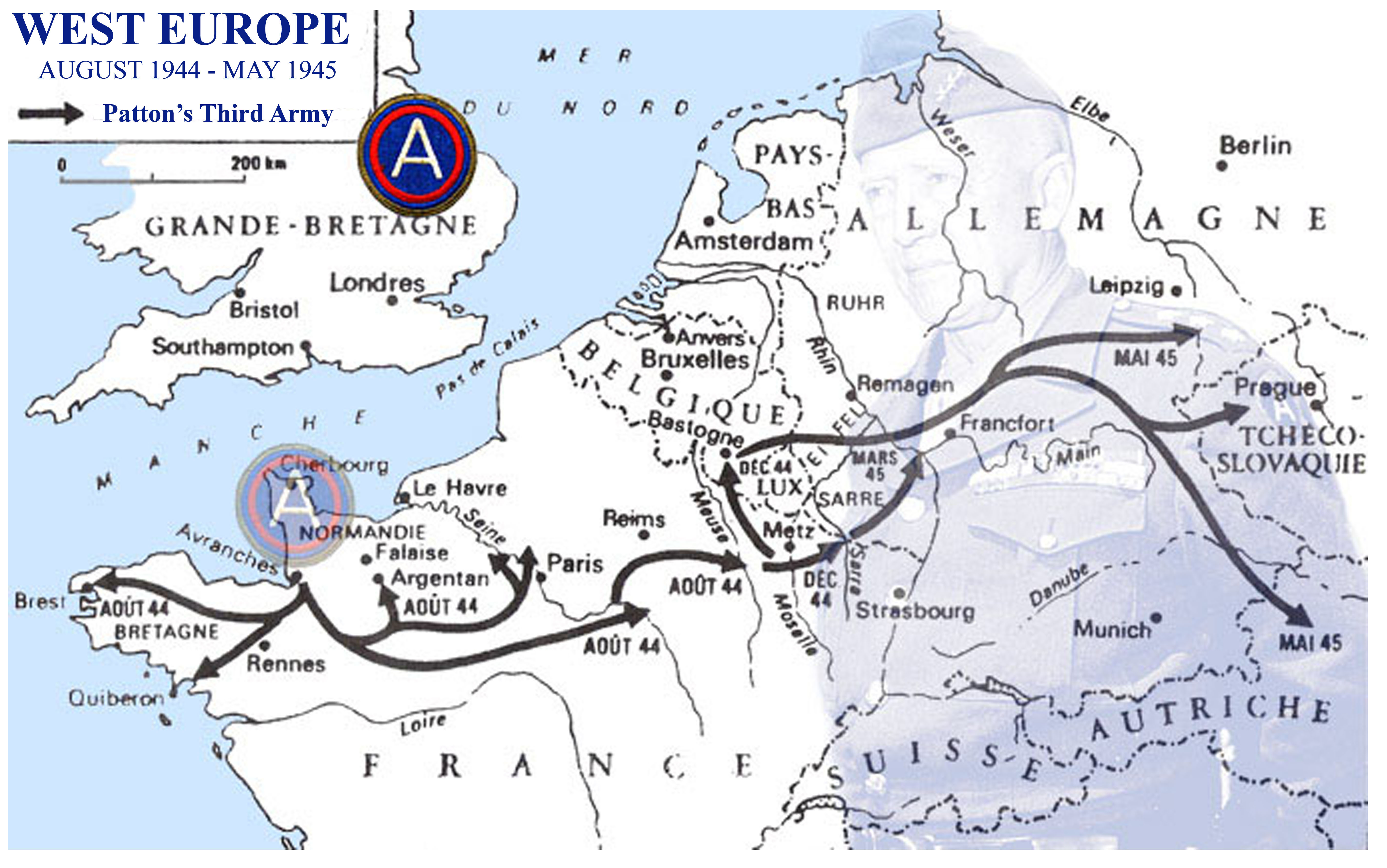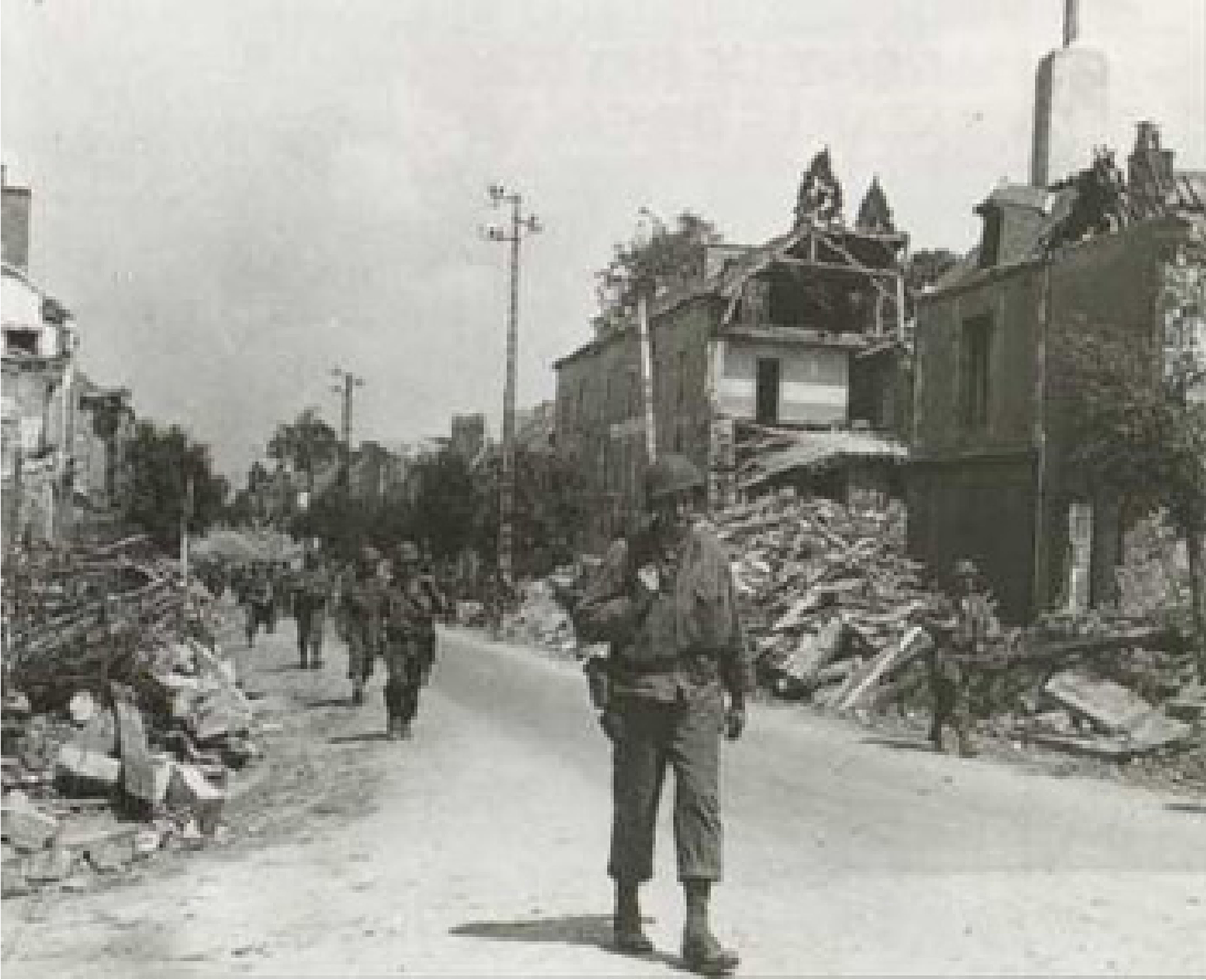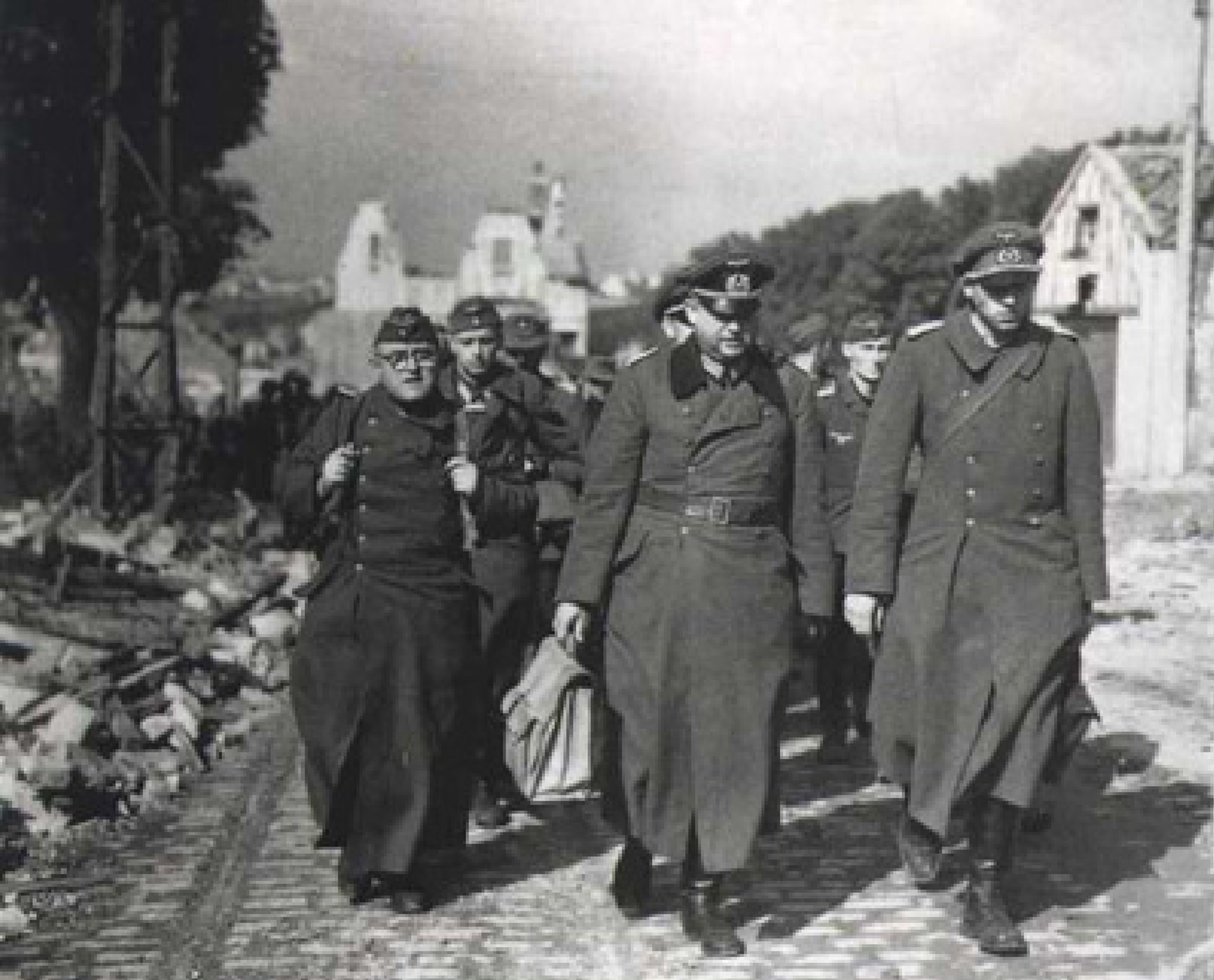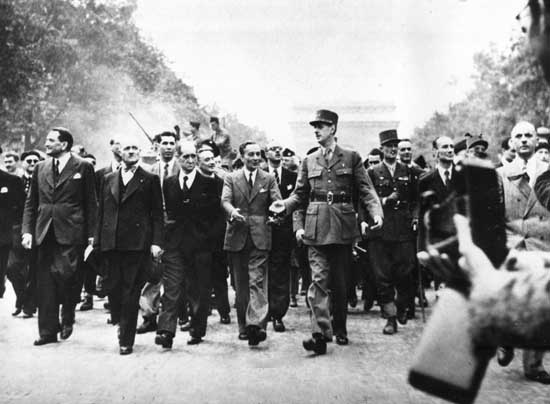On 22 Jan 1944, Patton received word of his selection to lead the Third Army. Planned as an exploiting element once the initial lodgment had been established ashore in Normandy, the Third Army barely existed as a fighting force. With many of the divisions untried and staff echelons inexperienced, Patton again had to start from scratch and mold his army into a "hell on wheels" outfit. Luckily, he was able to keep his principal Seventh Army staff officers including his G-4, Walter J. Muller, who "functioned with such efficiency that Patton rarely inquired into his methods." With operations in France expected to last considerably longer than Patton's two previous campaigns (Tunisia and Sicily at 30 and 38 days respectively), the Third Army had to quickly plan and prepare for logistics support on a much larger scale.

In mid-March, Patton greeted the remainder of his staff officers at Peover Hall near Knutsford, England to outline his plans for bringing Third Army up to fighting shape in the few remaining months before its commitment to combat. The Engineers busily conducted "analyses of bridge requirements, road studies, traffic circulation plans, computation of supply requirements, and survey and mapping plans." Patton even read The Norman Conquest by Edward A. Freeman, "paying particular attention to the roads William the Conqueror used in his operations in Normandy and Brittany.". According to Colonel Everett Busch, Third Army Quartermaster General, "this question was the most difficult in many respects of any encountered during the preliminary phase." It also underscored the strategic and operational concerns logistics was playing in Europe's liberation and indirectly the combat ability of Third Army.
Besides leading the Third Army, Patton also "commanded" the fictitious First U. S. Army Group (FUSAG). As part of the FORTITUDE SOUTH component of BODYGUARD, Patton and FUSAG were created to deceive German intelligence into believing the Pas de Calais would be the actual landing areas for D-Day. The German High Command (OKW) determined Patton would lead the invasion force and his billeting in Southeastern England plus the combination of real and fake units added to the deception.
Patton and FUSAG kept up "appearances" even after the invasion. Deception operations continued until the first week in August, but with Patton's quiet deployment to France on 4 July, BODYGUARD continued to diminish in effectiveness. Trading his comfortable English manor for a canvas tent in a Norman orchard, Patton prepared to activate his headquarters known as "Lucky Forward." En route, or already in France, were five hundred units of the Third Army awaiting orders to attack.
By 25 July, the size of the Allied beachhead had not even come close to the dimensions that pre D-day planners had anticipated, and the slow progress revived fears in the Allied camp of a return to the static warfare of World War I. Few would have believed that, in the space of a month and a half, Allied armies would stand triumphant at the German border.
As July turned to August, changes in the American command structure brought a dynamic new figure to the stage. Officially activated on 1 August 1944 (but not publicly acknowledged until 15 August), Operation COBRA and the breakout from Normandy brought the Third Army finally into action. Overbearing, often profane, yet also sensitive and deeply religious, Lt. Gen. George S. Patton, Jr., had already earned a reputation as an outstanding field general, as well as a frequently difficult subordinate, in North Africa and Sicily. Few, if any, commanders in World War II could match his talent for mobile warfare, his ability to grasp an opportunity in a rapidly changing situation, and his relentless, ruthless drive in the pursuit. The buildup and expansion of the Allied lodgment had now reached the point where Bradley could bring the Third Army head-quarters and its flamboyant leader into the field. He himself assumed command of the new 12th Army Group, and Lt. Gen. Courtney H. Hodges, a modest and competent professional, took his place at First Army. Third Army would command VIII Corps and the new XV, XX, and XII Corps as well as the 2d French Armored Division, while First Army retained control of the V, XIX, and VII Corps. Although introduction of an American army group was supposed to be followed by the assumption of overall command in the field by the Supreme Commander, General Dwight D. Eisenhower deferred this step until he could physically establish his headquarters on the Continent.

Turning the corner at Avranches, Patton's Third Army raced west into Brittany. Hitler had ordered his troops to hold the ports "to the last man," tying down American units and keeping the ports out of Allied hands as long as possible. However, German disarray enabled the Allies to send only VIII Corps into Brittany, rather than the entire Third Army as earlier planned. At Patton's direction, Middleton flung the 4th Armored Division toward Quiberon Bay to cut off the peninsula at its base, while the 6th Armored Division drove from Avranches west toward Brest at the extreme tip of Brittany, bypassing strongpoints along the coast in an effort to seize the port before the Germans could react. Eager to finish its work and join the main drive farther east, the 4th Armored seized Rennes and encircled Lorient, on the southern coast of Brittany. The 6th Armored covered the 200 miles to Brest in five days, but the tankers found the city's defenses too strong to take by a quick thrust. Not until 18 September did VIII Corps units finally batter their way into Brest and force the garrison's surrender. To the east, it took a rugged, house-by-house fight by the 83d Infantry Division to occupy the ancient Breton port of St. Malo. By the time the Breton harbors came under Allied control, demolitions had rendered them useless, but events to the east had already reduced them to minor importance.
The Allies had moved quickly to take advantage of the dangling German flank east of Avranches. By 3 August, Allies had decided to send just one corps into Brittany and turn the rest of 12th Army Group east in an effort to destroy the German Seventh Army west of the Seine. Under Patton's Third Army, Maj. Gen. Wade H. Haislip's XV Corps, which had been acting as a shield for the VIII Corps' move into Brittany, drove east to Mayenne, Fougeres, and Laval, scattering the few German units in its path. To the north, Hodges' First Army ran into tougher opposition, particularlyon the V Corps and XIX Corps fronts, where Gerow and Corlett were encountering stubborn resistance in their advance toward Vire. Collins' VII Corps enjoyed easier going on First Army's right, capturing the key road center of Mortain and racing south to link up with the XV Corps at Mayenne. American troops were moving rapidly, but Bradley viewed with great unease the narrow Mortain-Avranches corridor which connected his far-flung units.Bradley's unease was well founded.
Hitler's obstinacy created a golden opportunity for the Allies. Assured by Hodges that First Army could hold at Mortain, Bradley presented Montgomery with a proposal on 8 August. From the eastern end of the crescent, which represented the Allied front, First Canadian Army had started an offensive toward Falaise, and Bradley now proposed that Patton's Third Army, on the extreme southwest, drive across the German rear to link up with the Canadians and trap the Germans in a gigantic pocket. From Le Mans, which it had reached on 8 August, Haislip's XV Corps drove toward Argentan. A 25-mile gap lay between Haislip's forces and VII Corps' flank at Mayenne, but the Germans were too widely dispersed to take advantage of XV Corps' exposed position. On 12 August, XV Corps troops seized Alencon, about twenty-five miles south of Argentan, and Patton authorized a drive north toward Argentan and Falaise to meet the Canadians, who, slowed by fierce opposition and command inexperience, were still far north of Falaise.
At this point, Bradley halted Third Army short of Argentan, despite Patton's vigorous protests and jovial offers to "drive the British into the sea for another Dunkirk." The order remains the subject of considerable controversy, with many arguing that Bradley should have crossed the army group boundary line and completed the encirclement. Actually, as of 13 August, few German units had left the pocket, theFuehrer had authorized a withdrawal from the Mortain area to counter the growing threat to Seventh Army's rear, but only as a temporary measure prior to a renewal of the offensive to the west. The troops in the pocket, however, were unable to mount a major, coordinated blow in any direction. Lacking resources, especially fuel and ammunition, and under pressure from the repeated Allied blows, they could do little more than fight a series of delaying actions around the fringes of their perimeter.

By then, on 14 August, the Third Army command center directed Haislip's freewheeling XV Corps to head east for the river. Encountering little resistance, Haislip's columns quickly covered the sixty miles to the city of Dreux and then turned northeast to establish a Seine bridgehead at Mantes Gassicourt on the night of 19-20 August. Also farther south, Third Army was encountering even less opposition in its drive through the open plains north of the Loire Valley. Whether exhorting his troops at the front or scanning maps at his command post, alternately exultant in victory and raging over delays, Patton relentlessly pressed his advance to the Seine. He left only scattered detachments, reconnaissance aircraft, and French partisans to watch his long flank along the Loire. On the left, Maj. Gen. Walton H. Walker's XX Corps, with the 7th Armored Division in the lead, reached the ancient city of Chartres, with its famous cathedral, on 18 August, while on the right the XII Corps, initially under Maj. Gen. Gilbert R. Cook and later under Maj. Gen. Manton S. Eddy, occupied Orleans on 16 August, dashing German hopes for a defense of the Paris-Orleans gap. Bradley had initially planned to halt Third Army at those two points to permit his logistics to catch up with his advance, but, at Patton's urging, he agreed to a further advance to the upper Seine. Walker's XX Corps advanced through Fontainebleau to establish a bridgehead on the Seine at Melun, while the XII Corps seized a bridgehead farther upstream at Sens. By 25 August, Third Army possessed four footholds on the upper Seine.
As American columns rolled through French towns during those hot, dusty days in August, they were met by a jubilant populace aware that their arrival signified the end of German occupation... The Germans often departed before American troops made their appearance, as their lines of retreat were threatened by the rapid advance. This withdrawal contributed to the impression in some quarters that the Resistance, not the Allies, had liberated France. In most cases, the arrival of the Americans consisted of a few reconnaissance vehicles being met by a delegation on the outskirts of town. Then the celebrations would begin as church bells rang and townspeople cheered' sang, danced, and produced bottles of wine hoarded for the occasion. The American liberators were serenaded, hugged, kissed, and showered with food and drink. Not surprisingly, it was a reception that most would remember with great fondness.
The celebration most anticipated by American soldiers, and by the Allies in general, was the one expected to follow the liberation of Paris. British Prime Minister Winston Churchill had told Eisenhower before D-day that, if the Allies could free "beautiful Paris" by winter, he would consider it the greatest victory of modern times. As Allied columns neared the French capital in late August, however, Eisenhower appeared in no great haste to enter the city. Allied planners feared that their troops would bog down in street fighting, which would cause considerable destruction. They also were leery of becoming involved in French political disputes, which would inevitably follow liberation of the capital. Furthermore, Eisenhower's headquarters was not eager to assume the burden of feeding the millions of people in Paris. Despite the pleadings of French officers under them, Eisenhower and Bradley much preferred to bypass the city and use the supply tonnage saved to maintain the advance to the German border.
Events and French pressure soon changed Eisenhower's mind. To Frenchmen, Paris represented not just the political but also the spiritual capital of France, a symbol which must be redeemed from the occupier at the earliest possible moment. General Charles de Gaulle, head of the French Committee of National Liberation, needed Paris to solidify his position for the postwar French political struggle. Within the capital, Gaullists, Communists, and other political factions were already jockeying for position, clashing with each other and with the German garrison, which was under orders from Hitler to destroy the city before letting it fall to the Allies. Matters came to a head on 19 August, when the Resistance seized government and newspaper buildings and the city hall. The partisans lacked enough strength to expel the Germans from Paris on their own, so they agreed to a truce which would permit the garrison to use sectors of Paris in return for a German promise to release political prisoners and to treat some areas of the city as safe havens for the urban maquis. On 22 August, Resistance emissaries informed the Allied high command that the end of the truce was imminent and pleaded for help. Under pressure from de Gaulle and assured by the emissaries that the Germans were only waiting for the arrival of Allied troops to surrender, Eisenhower reconsidered his decision to bypass Paris. He now agreed to send a relief force, in part as a reward for partisan assistance during the campaign.
To spearhead the drive into Paris, Eisenhower had earlier decided to use the 2d French Armored Division, a Free French unit part of the Third Army, whose commander, Maj. Gen. Jacques Philippe Leclerc de Hauteclocque, had been agitating for permission to liberate Paris. According to the plan approuved by Patton, the French would go into Paris from the west, while the American 4th Infantry Division attacked from the south. When the French began their drive on the morning of 23 August, however, they made little initial progress. The Germans were fighting hard along the roads leading into the capital, and Americans wryly noted delays caused by crowds of Frenchmen who lined the roads bestowing flowers, kisses, and wine on their heroes. Not realizing the extent of German opposition, the American generals perceived that Leclerc's division was "dancing its way into Paris,". By midnight of 24 August, the tankers had fought their way into the heart of the capital, and on the following day Leclerc took the surrender of the German commander in the name of the Provisional Government of France.

Paris went wild with joy. Although several pockets of German soldiers still held out in various parts of the city, including 2,600 troops in the Bois de Boulogne, cheering crowds welcomed the French and American troops pouring into the capital. Entering Paris unannounced on 25 August, Gen. de Gaulle the next day made his official entry from the Place de l'Etoile to the Place de la Concorde amid thunderous acclaim, despite scattered shots from snipers. Eisenhower, parade the 28th Infantry Division through Paris on 29 August.
Aware of the supply problems involved, Eisenhower viewed Montgomery's more extravagant arguments of the advantages of a single thrust with skepticism. Eisenhower's changing decisions on strategy permitted Bradley to allot enough resources to maintain Patton's drive on Metz. The old fortress city, a critical point in past wars, had long held a special fascination for Third Army's commander. To reach Metz, Patton's troops had to pass a series of river barriers made famous by World War I, including the Marne, Vesle, Aisne, Meuse, and Moselle Rivers. Fortunately for Third Army's troops, the scattered Germans in their path lacked the strength to do much more than buy time through a series of rearguard actions. For the Americans, the ensuing pursuit in the last days of August thus proved an exhilarating experience. Reconnaissance units and cavalry fanned out over wide areas to locate river crossings and capture isolated parties of Germans, most of whom were only trying to return to the Reich as quickly as possible. Crossing the Marne, the XII Corps seized Chalons on 29 August and raced to establish a bridgehead over the Meuse on 31 August. On the left, the XX Corps passed the old World War I battlefields at Verdun and the Argonne before crossing the Meuse on 1 September. Once at the Meuse, Third Army halted temporarily to bring up supplies.
At this point, the supply crisis, which had been looming on the horizon for weeks, reached critical proportions. Eager to maintain pressure on the Germans, the Allies had repeatedly disregarded longterm logistical considerations for immediate combat benefits, and they were beginning to pay the price. By the end of August, neither First nor Third Army had any appreciable ration or ammunition reserves. Equipment and vehicles were wearing out, and gasoline stocks were being consumed as soon as they arrived. Although the Allies still lacked port capacity, the problem lay less in the amount of supplies on the Continent than in their transportation to the front. West of the Seine, the railroads had been ruined by pre-D-day bombing and sabotage, forcing the Allies to rely heavily on scarce trucks, which themselves consumed large quantities of petroleum. Furthermore, the unanticipated speed of the advance had left supply planners with little time to develop a system of intermediate depots to cover the 300 miles from the beaches to the front. Consequently, Allied logisticians had to resort to considerable improvisation, such as pressing chemical warfare and artillery trucks into service to haul supplies, using air transport and captured stocks, and instituting the Red Ball Express, two one-way truck routes to bring critical supplies forward as quickly as possible. In some places, supply officers hijacked convoys meant for other units.
As the Americans approached the West Wall and the German border, the pace of their advance was slowing and, in some cases, stopping due to the lack of gasoline. Farther south, Patton's Third Army had resumed the offensive on 5 September but was encountering tough resistance in its attempts to establish bridgeheads near Metz and Nancy
For the U.S. Army, the campaign represented one of its most memorable moments during World War II. The pursuit across France showed the Army at its slashing, driving best, using its mobility to the fullest to encircle German formations and precluding any German defensive stand short of their own frontier. American troops would long cherish memories of triumphant passages through towns, basking in the cheers of a grateful, adoring populace. More informed observers would point to D-day as the point at which German defeat became inevitable, but the Northern France Campaign drove home to almost all that Germany had lost the war. While Hitler could still hope that secret weapons or a surprise counteroffensive would retrieve his fortunes, and while destruction of the Nazi regime would in the end take a longer, harder fight than seemed likely to jubilant Allied troops in mid-September, the Allies in northern France had taken a giant step toward ultimate victory.
General George S. Patton and the accomplishments of the Third Army will continue to be a testament to the bravery and adaptability of the American warrior. First was Patton's extraordinary knowledge of military history. Studying the campaigns of Alexander, Caesar, and Napoleon provided Patton with more than lessons in leadership and command-their successes as great commanders relied on logistical prowess. In addition, Patton understanding and incorporating the latest technology, employment of combined arms, and his genuine concern for the troops provides leaders alike a worthy example to study and emulate.
"His military leadership acumen proved decisive against enemy forces from North Africa to the Rhine River. This paper illustrates General George S. Patton's experience before assuming command of the Third Army in 1944. Though sixty five years have elapsed since Patton's Third Army raced across the French countryside and into Germany, this incredible feat of combined arms still offers fresh insights for today's warriors. Patton may have been "hell on wheels," but his Third Army's accomplishments depended upon the agile combat support provided by his quartermasters scattered throughout the European Theater of Operations."


